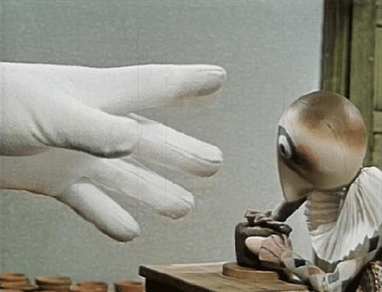
With my addiction to all things stop-motion growing by the hour, I am lucky enough to have friends, (enablers), who fuel my habit. A while back I opened my messages to find a link with the word ‘creepy’ written underneath. My editor had stumbled across something just plain menacing and thought of me immediately. Isn’t that sweet? (Ed: It's how we express love).
What was in the link was a curious and brilliantly imaginative short by one of the Czech Republics most celebrated animators and illustrators. For this month’s Movies in Motion we look at the work of Jiri Trnka with one of his last short films, Ruka.

Trnka began his prominent career as an illustrator of children’s literature as well as native Czech folk law. Most noted is his work for The Brothers Grimm as well as other prominent folktale authors. His work led to Trnka writing his own stories and he eventually formed his own puppet theatre. He began his career as animator with 2D animation which won him numerous critical acclaim. Despite his success Trnka moved away from traditional animation and began experimenting with different stop-motion techniques. He also began to do more work involving satire and work around political themes.
His broad range includes shadow puppetry as well as using cut outs to animate with the bulk of his film work is done using puppets. The drawn back of this is their lack of facial movement and manipulation. This would usually have been overcome by morphing with other animation forms but Trnka instead relied on lighting and music to create tone and progress narrative. Both these things are obvious in Ruka.

Where the lack of movement and facial expression cannot communicate lighting as well as colour are heavily used. From changing backdrops, that each reflect the altered mood of the scene, to the use of a melting candle to display time. The opening light, with in the potter’s home, is bright even as the unwelcomed hand descends. As the hand uses different means of persuasion blacks and blues fill the scene. The lighting turns mute to represent foreboding danger. Once the hand imprisons the potter a fade out is used to signify it taking control. The potter is placed in a bird cage and made to erect a statue of the hand to a cold, blue, dimly lit backdrop.
As neither the artist nor the hand can speak the score and sounds are used heavily to communicate thoughts and tone. The short opens on a whimsical tune that the potter awakens too. It is a stark contrast to the later tunes heard and would suggest a much lighter in tone piece.
The dominant accompaniment in the piece is sound. From the creaky sound of the potter’s wheel to the thumping of the hammer used against the hand. A phone ringing as well as a ticking clock are also heard. The sounds are a mixture of diegetic and non-diegetic. Although not always accurate or natural, they like the short feel heightened. As well as music and sound long periods of silence are used which represents the potters isolation.

The hand itself could be seen as a metaphors for the government, a ruling system or frankly the man. The hands persistence in altering the potter’s artistic vision could be a reference to Trnka himself. Whichever way you read the piece it is still striking by today’s standard of stop-motion.
The medium may be most associated with models as well as clay but for Trnka the use of puppets was his personal preference. The result is an eerie and distinctive appearance.
Trnka is sometimes referred to as the European Walt Disney. The comparison is unimaginative to say the least and it is sad that every prominent animator is labelled as a new Disney. His body of work and accomplishments are his own and he crafted an impressive legacy in his lifetime. After visiting Prague myself last year the large number of wooden puppets and creatures on display makes sense.
A surreal but striking piece of animation by the Czech pioneer. The work may be a stepping stone in the progression of stop-motion but a beautiful period it was indeed.
If not a little ‘creepy’.

 RSS Feed
RSS Feed
